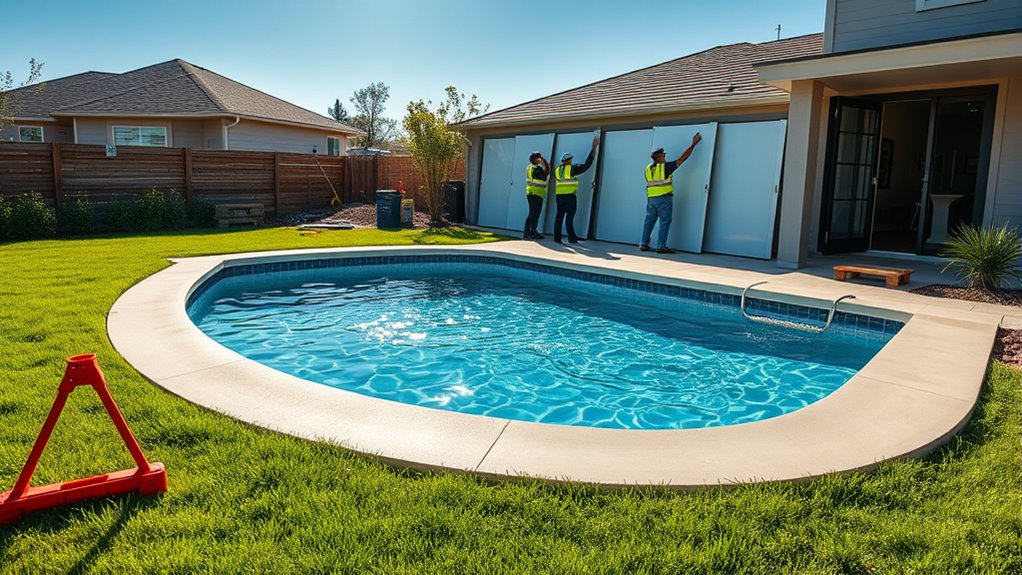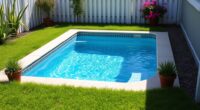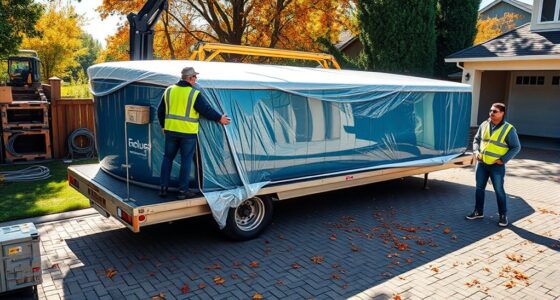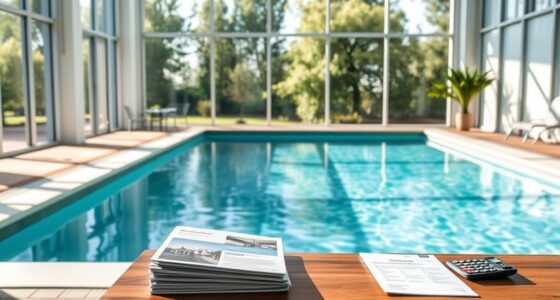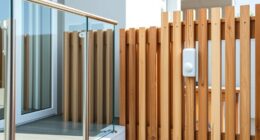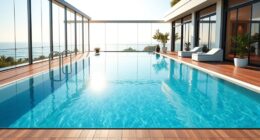To install your endless pool, start by evaluating your backyard and planning the layout carefully. Choose the best location, then prepare the site through excavation and foundation work. Next, install the pool shell, connect plumbing and electrical systems, and set up filtration. Once everything is in place, fill the pool and run system checks. With final safety tweaks, you’ll be ready for your first swim. Keep going to learn more about each step and guarantee a flawless installation.
Key Takeaways
- Assess and prepare the site by measuring space, choosing an optimal location, and leveling the ground for a stable foundation.
- Install the pool shell carefully, ensuring proper placement, support, and secure fastening on a solid foundation.
- Connect plumbing, electrical, and filtration systems following safety codes and manufacturer guidelines for efficiency and durability.
- Perform system checks, fill the pool with water, and verify leaks, proper flow, and system functionality before proceeding.
- Conduct safety inspections, adjust water temperature, and prepare the pool for the first swim with proper chemical balance and cleaning.
Assessing Your Backyard Space and Planning the Layout

Before installing an endless pool, you need to evaluate your backyard to guarantee it can accommodate the setup. Measure your available space carefully, considering both the pool’s dimensions and extra room for access, maintenance, and landscaping. Think about the shape of your yard and how the pool will fit within it, ensuring there’s enough clearance for doors, walkways, and nearby features. Take note of existing structures like trees, fences, or utility lines that might interfere with installation or future use. Consider the slope of your terrain as well—flat, level ground makes setup easier, while uneven terrain may require grading. Planning your layout thoughtfully now will save you time and effort later, creating a functional, attractive space for your new endless pool. Additionally, evaluating the overall backyard layout ensures that your pool complements the existing landscape and maximizes its aesthetic appeal.
Selecting the Perfect Location for Your Endless Pool
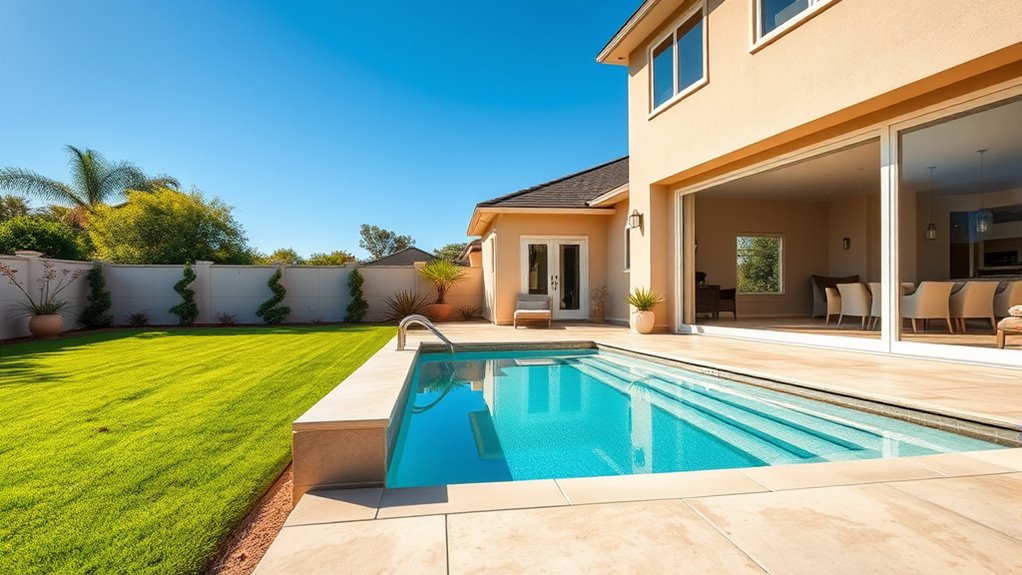
Choosing the right spot for your endless pool is vital to guaranteeing it functions well and enhances your backyard. First, consider accessibility—place it where you and guests can easily reach without obstacle. Think about privacy; locate it where neighbors won’t have an unobstructed view. Sun exposure is key, so pick a spot that gets plenty of sunlight while avoiding excessive shade. Check the drainage; avoid areas prone to flooding or pooling water. Additionally, consider proximity to power sources and water lines for easier installation. Make certain there’s enough space around the pool for maintenance, safety, and future landscaping. Finally, evaluate the terrain’s stability—select a flat, solid surface to support the pool’s weight and prevent shifting over time. Contrast ratio plays a role in how well the pool’s lighting and visual appeal will stand out, especially in different lighting conditions.
Preparing the Site: Excavation and Foundation Setup
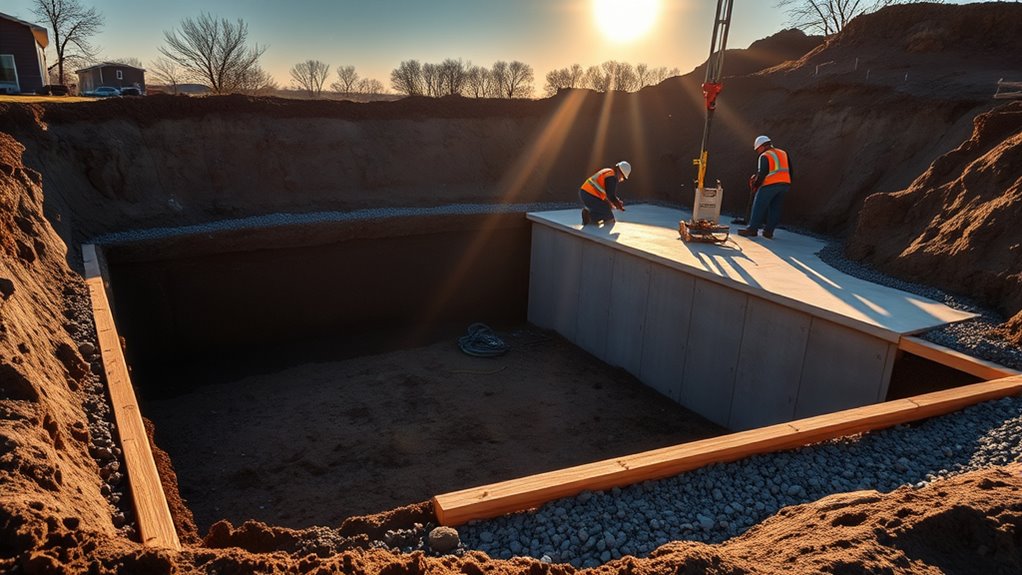
Before you begin excavation, you need to clear and level the site to guarantee a stable foundation. Choosing the right foundation material is vital for supporting the pool properly and preventing shifting or settling over time. Pay close attention to these steps to set a solid base for your endless pool installation. Incorporating proper workspace setup can help streamline the process and ensure safety throughout the project.
Site Clearing and Leveling
To guarantee your endless pool installation starts off on solid ground, you need to clear the site thoroughly and level the area precisely. Begin by removing any debris, rocks, or vegetation that could interfere with construction. Use a shovel or a skid steer to clear the surface and ensure the area is free of obstructions. Next, check for uneven spots by placing a level on the ground; fill in low areas with gravel or soil and compact them well. A flat, even surface is essential to prevent shifting or settling later on. Double-check measurements to confirm the site matches the pool’s specifications. Proper clearing and leveling create a stable foundation, reducing future issues and ensuring a smooth, safe installation process.
Foundation Material Selection
Selecting the right foundation material is essential to guarantee your endless pool remains stable and secure over time. You want a material that provides a solid, level base and supports the weight of the pool and water. Concrete is a popular choice because of its durability and strength, ensuring long-term stability. Gravel offers excellent drainage and can be a good base if compacted properly. For smaller or temporary setups, compacted sand might suffice, but it’s less stable. Avoid materials that shift or settle unevenly, as they can cause structural issues later. Consider your site’s soil conditions and consult with a professional to choose the best foundation material. Proper selection now prevents costly repairs and guarantees a safe, long-lasting installation. Additionally, understanding soil stability and ground assessment can help determine the most suitable foundation for your specific site.
Installing the Pool Shell and Structural Components

Have you ever wondered how the pool shell becomes the sturdy foundation of your endless pool? First, you position the pre-fabricated shell carefully onto the prepared foundation, ensuring it aligns precisely with your layout. Using cranes or lifts, you lower the shell into place, avoiding damage. Once in position, you secure it to the foundation with specialized fasteners or anchors. Structural supports, like reinforced beams or framing, are then installed around the shell to add stability. Proper installation practices are essential at this stage to ensure the longevity and safety of your pool. This step requires careful attention to detail to prevent shifting or misalignment. After securing the shell, you double-check all connections and supports, ensuring the entire structure is solid and level. Proper installation at this stage is critical for the longevity and safety of your pool.
Connecting Plumbing, Electrical, and Filtration Systems

Connecting your pool’s plumbing, electrical, and filtration systems is vital for proper operation. You’ll need to follow plumbing layout essentials, ensuring all pipes are correctly positioned and sealed. Additionally, adhering to electrical connection guidelines and setting up the filtration system properly will keep your pool running smoothly. Incorporating energy-efficient components can also help reduce operational costs and enhance system longevity solar energy insights.
Plumbing Layout Essentials
To guarantee your endless pool functions smoothly, it is crucial to carefully plan the plumbing layout that connects the water, electrical, and filtration systems. Start by mapping out the placement of pipes for water circulation, ensuring they run directly from the filtration unit to the pool without sharp bends or obstructions. Use durable, flexible piping that can withstand water pressure and temperature changes. Keep the filtration system close to the pool for efficient operation, and make sure the connections are secure and leak-proof. Properly aligned plumbing minimizes friction and turbulence, reducing strain on pumps and filters. Remember to leave access points for maintenance or repairs. A well-designed layout ensures ideal flow, reduces downtime, and keeps your pool running smoothly for years to come. Additionally, considering preppy dog names for your poolside canine companion can add a touch of sophistication to your outdoor space.
Electrical Connection Guidelines
Ensuring your electrical system is properly integrated with the plumbing and filtration components is essential for safe and efficient pool operation. First, confirm that your electrical connections adhere to local codes and manufacturer instructions. Use a dedicated GFCI outlet to power the pool equipment, preventing electrical shocks. Run wiring in weatherproof conduit, avoiding damage or exposure to moisture. Keep wiring separate from plumbing lines to reduce interference or corrosion risks. Install a dedicated breaker for the pool system, and ensure all connections are secure and properly grounded. Before powering up, double-check that all electrical components are correctly wired and protected. Properly grounding and following safety protocols minimizes hazards, ensuring your endless pool functions smoothly and safely for years to come. Additionally, understanding electrical safety standards can further help prevent potential hazards during installation.
Filtration System Setup
Before you start linking the plumbing, electrical, and filtration components of your endless pool, it’s important to plan each connection carefully. Begin by confirming the filtration system’s placement aligns with your pool’s layout, ensuring easy access for maintenance. Connect the inlet and outlet hoses securely, avoiding leaks that could compromise water quality. Make sure your pump and filter are wired correctly, following your electrical plan to prevent overloads. Use appropriate fittings and clamps, and double-check connections for tightness. Once everything is connected, fill the filter with water and run the system briefly to check for leaks and proper flow. Proper setup here keeps your pool’s water clean, clear, and safe, setting the stage for a smooth, hassle-free operation. Additionally, understanding how AI-powered nanobots can potentially enhance water treatment processes may inspire innovative upgrades to your filtration system in the future.
Filling the Pool and Conducting System Checks
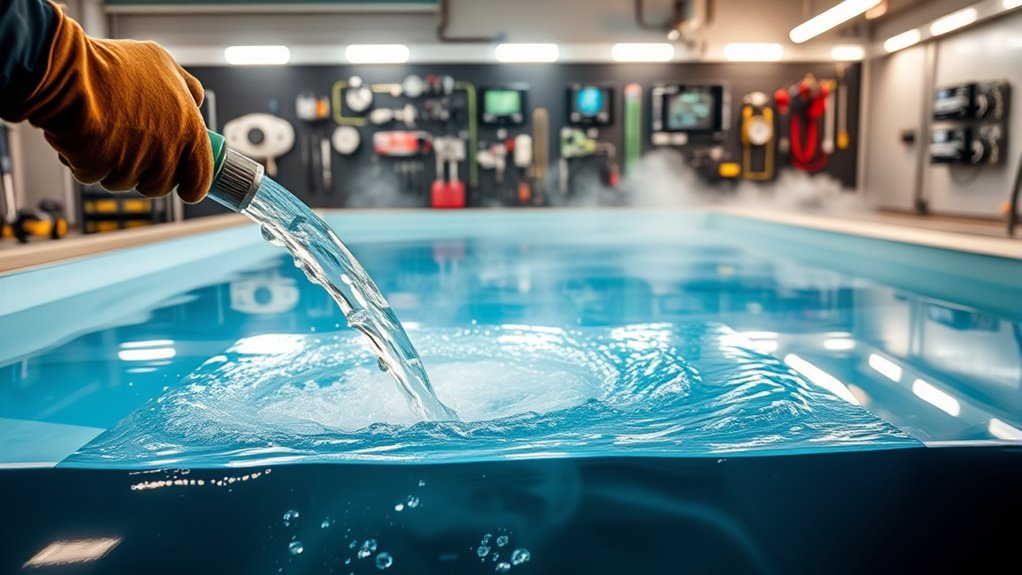
Once the pool is filled with water, you should carefully check all system components to guarantee they’re functioning correctly. Turn on the pump and circulation system, observing for any unusual noises or leaks. Confirm the filtration system operates smoothly and the water flows evenly through all jets. Check the heater, if installed, to verify it heats water properly without leaks. Use your control panel to validate system settings are correct and that sensors respond accurately. Inspect all valves and connections for tightness. If you notice any irregularities, troubleshoot immediately to prevent future issues. This step ensures the pool’s systems work harmoniously, setting the stage for safe, efficient operation. Properly completed checks now save you from problems later.
Final Adjustments and Safety Measures
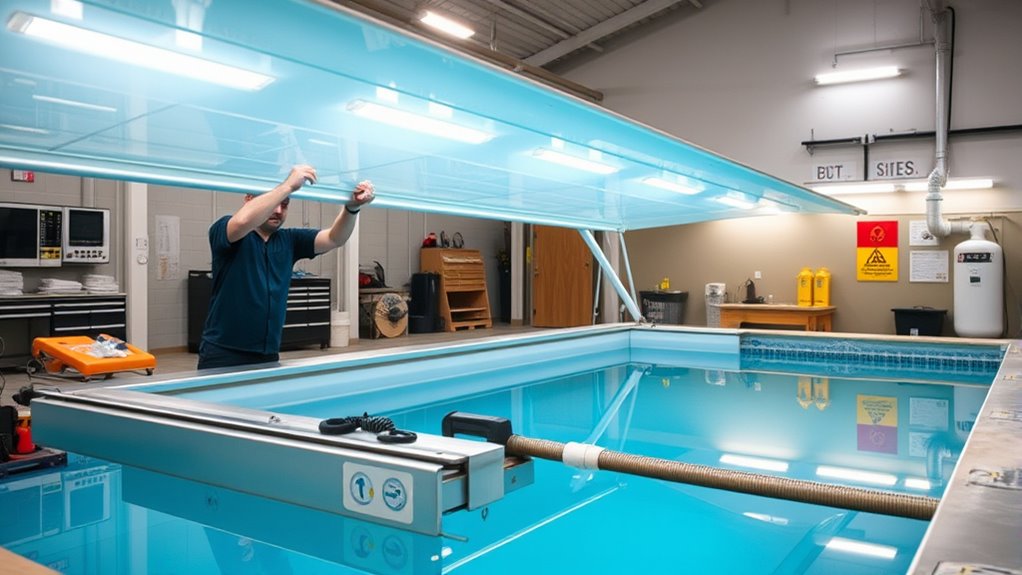
After completing the initial setup and system checks, it’s vital to make final adjustments to optimize your pool’s performance and safety. Check the water temperature to guarantee it’s comfortable and consistent. Adjust jets and flow rates for proper circulation and filtration. Confirm all safety features, like covers, alarms, and fencing, are correctly installed and operational. Regularly inspect for leaks, loose fittings, or electrical issues. Use the table below to guide your final safety checks:
| Step | Action | Purpose |
|---|---|---|
| Water temperature check | Adjust thermostat if needed | Comfort and safety |
| Jet and flow adjustment | Fine-tune for circulation | Pool efficiency |
| Safety feature check | Verify alarms, covers | Prevent accidents |
| Inspect for leaks | Tighten fittings, look for drips | Maintain integrity |
A thorough understanding of trustworthiness of Patchology can help inform your choices when selecting skincare products for poolside care and post-swim maintenance.
Filling the Pool and Conducting System Checks
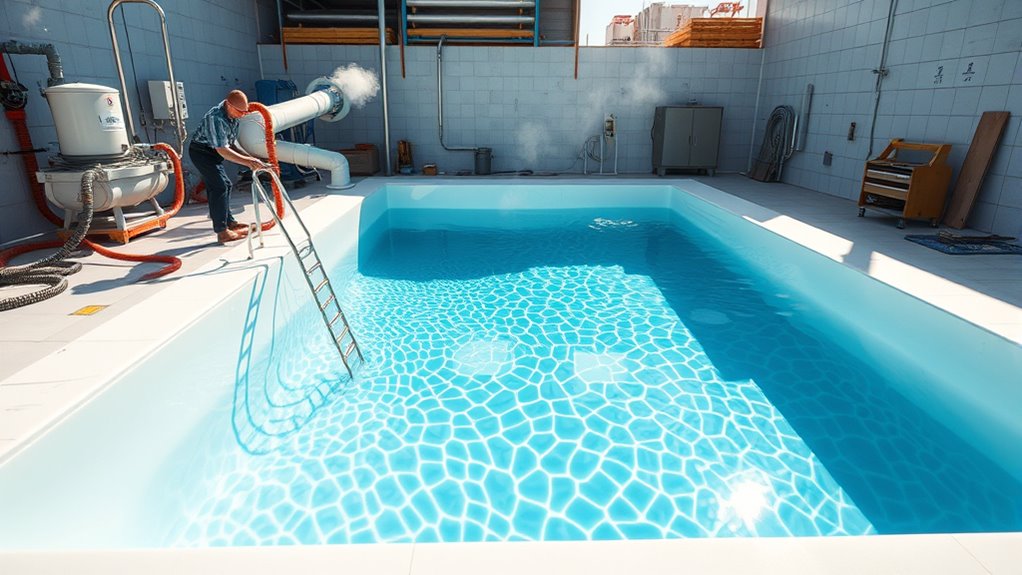
Have you prepared your pool for filling? Ensure the area around the pool is clear of tools and debris, and double-check all connections are secure. Before filling, verify that the filtration system and pump are properly installed and turned off. As you start filling the pool with water, monitor the level to prevent overflow or airlocks in the system. Once filled to the recommended level, turn on the pump and filtration system. Conduct thorough system checks by inspecting for leaks, listening for unusual noises, and confirming that water flows smoothly through all components. Make sure the heater and jets are functioning correctly. This step guarantees your pool operates safely and efficiently before you move on to final adjustments.
Enjoying Your First Swim and Ongoing Maintenance
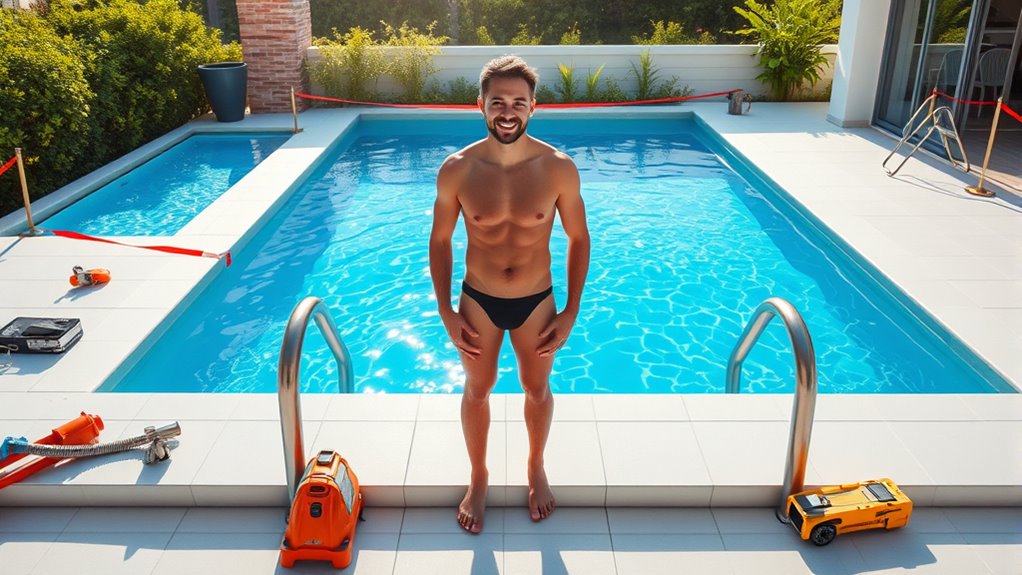
Starting your first swim is an exciting milestone; just be sure to test the water temperature and clarity beforehand to guarantee a comfortable experience. Once you’re in, enjoy the smooth, endless flow of your pool, paying attention to how the water feels. To keep your pool inviting, regularly check and maintain proper chemical levels, like pH and sanitizer. Clean the filter as recommended to prevent buildup and ensure clear water. Keep an eye out for signs of algae or debris, and address issues promptly. Cover the pool when not in use to minimize debris and evaporation. Consistent maintenance guarantees your endless pool stays safe, efficient, and enjoyable for years. Remember, regular upkeep keeps your first swim memorable and your pool in top condition.
Frequently Asked Questions
How Long Does the Entire Installation Process Typically Take?
The entire installation usually takes about 4 to 6 weeks, depending on your site’s complexity and scheduling. You’ll start with site prep, which can take a few days, then move to delivery and assembly. After installation, testing and finishing touches might add a few extra days. Stay in close communication with your installer to keep things on track and make certain a smooth setup for your first swim.
What Permits or Approvals Are Required Before Installation Begins?
Before starting your installation, you need to check local regulations for permits or approvals. Typically, you’ll require building permits, zoning approvals, or homeowner association permissions, depending on your location. You should contact your city or county building department early to understand their requirements. Securing these permits guarantees your project complies with safety codes and avoids potential fines or delays, making your pool installation smooth and hassle-free.
Can I Install an Endless Pool Myself or Should I Hire a Professional?
Thinking you can DIY your endless pool? Well, you’d be better off channeling your inner MacGyver than risking safety and compliance. Installing an endless pool isn’t a weekend project; it requires electrical, plumbing, and structural knowledge. Hiring professionals ensures proper installation, safety, and adherence to permits. Plus, it saves you time and stress. So, unless you’re a seasoned contractor, it’s best to trust the experts for a seamless, worry-free setup.
What Are the Common Challenges Faced During Installation?
You might face challenges like ensuring proper site preparation, which includes leveling and drainage, and dealing with limited space. Plumbing and electrical connections can be tricky if you lack experience, risking leaks or electrical hazards. Additionally, managing the weight and size of the pool during installation can be difficult without proper equipment. Planning ahead, following instructions carefully, and seeking professional help when needed can help you overcome these common hurdles smoothly.
How Do I Ensure My Pool Is Energy-Efficient and Cost-Effective?
To keep your pool energy-efficient and cost-effective, you should invest in a quality, energy-efficient pump and heater, and install a cover to reduce heat loss. Regularly maintain your pool by cleaning filters and checking for leaks. Use a programmable thermostat to control heating times, and consider solar heating options. Proper insulation and sealing also help minimize energy waste, saving you money over time.
Conclusion
Now, your endless pool is finally yours—a shimmering oasis nestled in your backyard. As you dip your toes in, imagine it as a mirror reflecting your dedication and dreams. With each swim, you’ll carve out moments of tranquility and strength, like a river carving its path through stone. Keep up with regular maintenance, and your personal paradise will continue to flow effortlessly, turning your backyard into a forever sanctuary of refreshment and joy.

